|
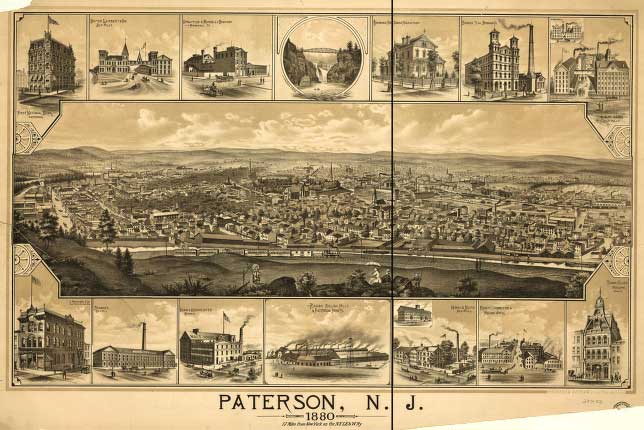
OTHER
IMPORTANT
INDUSTRIES IN
PATERSON
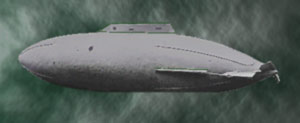 HOLLAND
SUBMARINES HOLLAND
SUBMARINES
John Philip Holland designed and tested his first submarines in Paterson.
The Holland I was fabricated at an iron works in New York City then moved to the J. C. Todd and Company
machine shop in Paterson in 1878. Here, a petroleum engine was installed for propulsion. The sub
measured 14 feet long. Trial runs were conducted in the Passaic River above the Great Falls. The boat
reached a depth of 12 feet and traveled at a speed of 3 1/2 miles per hour. The maximum submergence time
was about one hour.
Holland made many advances in submarine design, experimenting with
compressed air, steam and electricity as means of propulsion. Six of his submarines were built
altogether. The second Holland submarine, the Fenian Ram, was launched in 1881. It was a three-man boat
and made dives in excess of 45 feet. The last Holland submarine, the Holland VI, built in 1897, became
the first vessel in the U.S. Naval Submarine Fleet, commissioned as the U.S.S. Holland. This was a major
breakthrough in submarine design. For the first time, all the major components of submarine design were
present in one vessel - dual propulsion systems, a fixed longitudinal center of gravity, separate main
and auxiliary ballast systems, a hydrodynamically advanced shape, and a modern weapons system. It used a
gasoline engine while running on the surface and an electric motor while submerged. At top surface
speed, it could reach a speed of seven knots. Its length was 53 feet long. It had a range of 1000 miles
on the surface and 30 miles submerged.
Click here for excerpts from the Great Falls Visitor Center's Historic
Notes: The
Invention of Holland's Submarine.
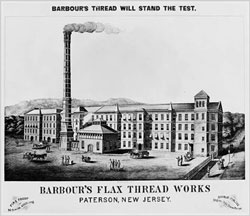 BARBOUR'S
FLAX THREAD WORKS BARBOUR'S
FLAX THREAD WORKS
Excerpts
from the NPS HAER
Report NJ-11:
The Barbour Flax
Spinning Company
was one of the
largest linen
works in the
country in the
second half of the
19th century,
employing some 440
people to process
over a million and
a half pounds of
flax
annually.
Thomas Barbour,
sent by his family
from Ireland to
establish an
American branch of
the family's
prosperous linen
thread company,
bought Passaic
Mill #2 in 1864
for $60,000.
He simultaneously
acquired the
rights to the two
square feet of
water deeded to
the lot and in
1865, leased an
additional
288" from the
S.U.M.
Rechristened the
"Belfast
Mill", the
building was
reoutfitted for
the production of
linen thread and
yarn.
Power
for the linen
works was supplied
by water from the
upper canal, and
by 1870, 120
horsepower was
being delivered
from a 54"
turbine
wheel. That
year, 40 men, 200
women, and 200
children tended
Barbour spindles,
processing
1,508,00 pounds of
Irish flax into
792,000 pounds of
machine thread,
150,000 pounds of
tailer's thread
and 20,000 pounds
of linen twines.
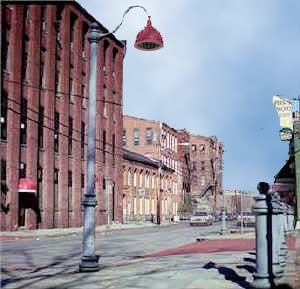
THE
PHOENIX MILL
Joachim
Velasquez, a
wealthy Mexican
who was living in
New York City,
founded the
Phoenix Mill in
1815. The mill
produced
candlewick and
cotton, later
switching to linen
and flax
production. In
1860, Benjamin
Tilt began silk
production on the
top floor of the
factory, and by
1865 he controlled
the entire
structure,
converting it from
cotton production
to silk. In the
1880s, the Phoenix
Company employed
8,000 people and
had 500 looms.
Click
here for excerpts
from the NPS HAER
REPORT NO. NJ-4: Phoenix Mill, Van Houten and Cianci Streets
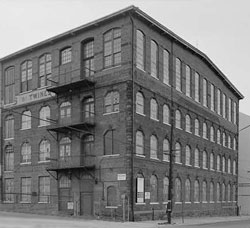
THE
DOLPHIN JUTE
COMPANY
The
Dolphin Jute
Company,
established in
1844, converted
hemp and jute into
twine, rope and
carpet backing.
One of Paterson's
largest mills, it
encompassed 17
buildings.
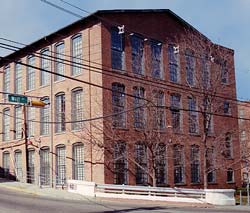
THE
FRANKLIN MILL
The
Franklin Mill,
earlier known as
the old "Red
Mill," was
burned and rebuilt
several times. The
current building
was constructed in
1870 and expanded
in 1915. It was
used to produce
cotton yarn, silk,
steam fire
engines, brass
domes for
locomotives, and
other machinery.
Within the past
decade, it has
been restored as
an office complex.
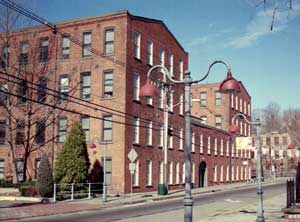
THE
ESSEX MILL
The
Essex Mill
occupies the site
that was the first
to be leased from
the S.U.M.
The current
building contains
a portion of the
original
"Yellow
Mill,"
which was built in
1807.
Charles Kinsey,
the first tenant
of this mill,
conducted one of
the earliest
attempts to
manufacture paper
using a continuous
sheet process.
Over the years,
this building was
reconstructed and
expanded to
produce cotton,
mosquito netting
and silk. It has
recently been
restored into
government
subsidized housing
for artists and
musicians.
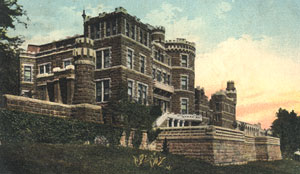 THE
LAMBERT MILL AND
DEXTER MILL THE
LAMBERT MILL AND
DEXTER MILL
Catholina
Lambert began work
as a ten-year-old
in a Yorkshire
cotton mill. At
seventeen, he was
an office boy in a
Boston silk firm,
Tilt &
Dexter. Two
years later, he
bought the shares
of a retiring
principal of the
firm and renamed
the company
Dexter, Lambert,
and Company.
He eventually
relocated it to
Paterson and by
1890, he was one
of the largest
mill owners in
Paterson.
There he made
enough money from
his five mills
(including two in
Pennsylavania) to
pay for the
English-style
castle he built on
Garret Mountain
and also for his
collection of some
400 original
paintings by
Renoir, Monet,
Courbet,
Rembrandt, and
others.
The
Silk Strike of
1913 put a great
strain on the silk
manufacturing
business.
Despite Lambert's
vast private
wealth, or perhaps
because of it (so
much of his income
had been spent in
economically
nonproductive
ways), he could
not recover from
the strike and was
forced to declare
bankruptcy.
His famous art
collection was
auctioned by the
American Art
Galleries in the
Grand Ballroom of
New York's Hotel
Plaza in
1916. The
sale of 365
paintings and
numerous
scupltures brought
him $592,050,
which was
estimated at about
one-third of the
real value.
Today, the Lambert Castle Museum is headquarters for the Passaic
County Historical Society and features gracious 19th century period rooms along with fascinating
exhibits relating to the history of Passaic County.
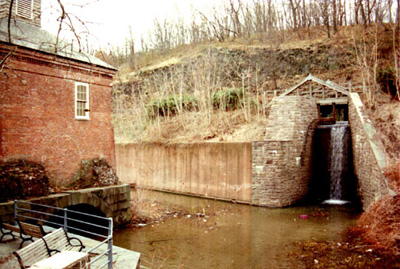 IVANHOE
PAPER
MANUFACTURING CO. IVANHOE
PAPER
MANUFACTURING CO.
One
of the most
extensive
industries in
Paterson was
carried out by the
Ivanhoe
Manufacturing
Company, which was
among the most
complete in the
world devoted to
paper production.
Henry V. Butler,
the founder of
this vast
establishment,
introduced the
process of boiling
stock under
pressure in rotary
boilers, a method
that was
universally
adopted throughout
this country and
in Europe. The
rope, cotton waste
and rags were
picked, cleansed,
boiled and
manipulated until
they left the mill
in the form of the
finest, whitest
writing paper.
In
1837, Roswell L.
Colt built a
substantial stone
mill, located on
the upper raceway,
especially for the
purposes of this
firm. The mill was
called the Passaic
Mill and it
furnished paper
for the most
foremost
publishers in the
country, including
the American Bible
Society, the
Methodist Book
concern, the
Appletons, Carter
Brothers and
others.
The
Ivanhoe Wheelhouse
was built in 1865
to house an
87-inch water
turbine that
supplied power to
the Ivanhoe
complex of ten
buildings. All of
the buildings are
gone now, except
for the
wheelhouse, which
was recently
restored. It sits
next to the
spillway between
the upper and
middle raceway.
Click
here for excerpts
from the
Great Falls
Visitor Center'sHistoric
Notes: The Ivanhoe Wheelhouse
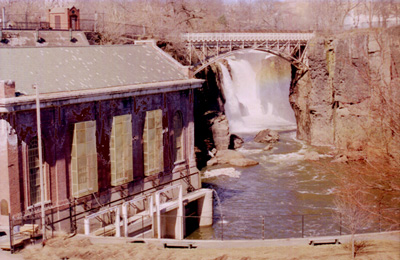 HYDROELECTRIC
POWER HYDROELECTRIC
POWER
In 1910, the
S.U.M. developed
plans to build a
hydroelectric
station at the
Great Falls to
replace the
waterpower from
the raceway. The
station had a
maximum capacity
of 6500
horsepower, with
its four huge
turbines
generating 21
million kilowatts
per year. It
operated from 1914
to 1969, at which
time the plant was
damaged by a
flood. Through
interest in
renewal, this
plant has been
restored to
working order. It
went back on line
December 31, 1986
and an overhaul on
the turbines was
started in October
1999.
Waterpower systems
use an energy
source that is
free. They do not
pollute and do not
use up the energy
source, but return
it unchanged to
the river.
Compared to fossil
fuels, they are
very efficient.
One disadvantage
to waterpower is
the reduction in
flowing water
caused by
droughts. However,
as fossil fuels
become more
costly, small
hydroelectric
sites, like the
one at the Great
Falls, are
becoming more
attractive.
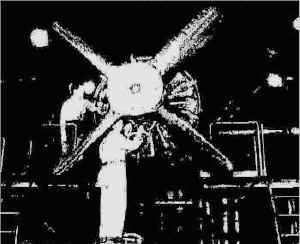 CURTISS-WRIGHT CORPORATION CURTISS-WRIGHT CORPORATION
During
World War II,
Paterson became a
major center of
Curtiss-Wright
engine production.
In 1920, the
Wright
Aeronautical
Corporation
designed and built
the Whirlwind and
Cyclone aircraft
engines, which
made aviation
history. In 1927
Charles Lindberg
had a 200
Horsepower J-1
air-cooled
Whirlwind Engine
custom-made for
his historic solo
Trans-Atlantic
flight. Through
the 1930's and
40's, the
company employed
as many as 25,000
workers and
manufactured over
120,000 various
types of aircraft.
It was during this
period of time
that Paterson was
called "The
Aviation City".
The
Curtiss-Wright
Corporation had a lot of
history in early
aviation with the
Wright in the name
coming from the
Wright Brothers.
This company was
of significant
importance to the
outcome of WWII.
They manufactured
the P 40 Warhawk
Fighter, C 46
Commando Cargo
Transport, SB2C
Helldiver Navy
Bomber, Army A 25
Helldiver, Seagull
Navy Scout Plane
and the Republic
Thunderbolt
Fighter.
 
|





 HOLLAND
SUBMARINES
HOLLAND
SUBMARINES  BARBOUR'S
FLAX THREAD WORKS
BARBOUR'S
FLAX THREAD WORKS



 THE
LAMBERT MILL AND
DEXTER MILL
THE
LAMBERT MILL AND
DEXTER MILL IVANHOE
PAPER
MANUFACTURING CO.
IVANHOE
PAPER
MANUFACTURING CO. HYDROELECTRIC
POWER
HYDROELECTRIC
POWER CURTISS-WRIGHT CORPORATION
CURTISS-WRIGHT CORPORATION